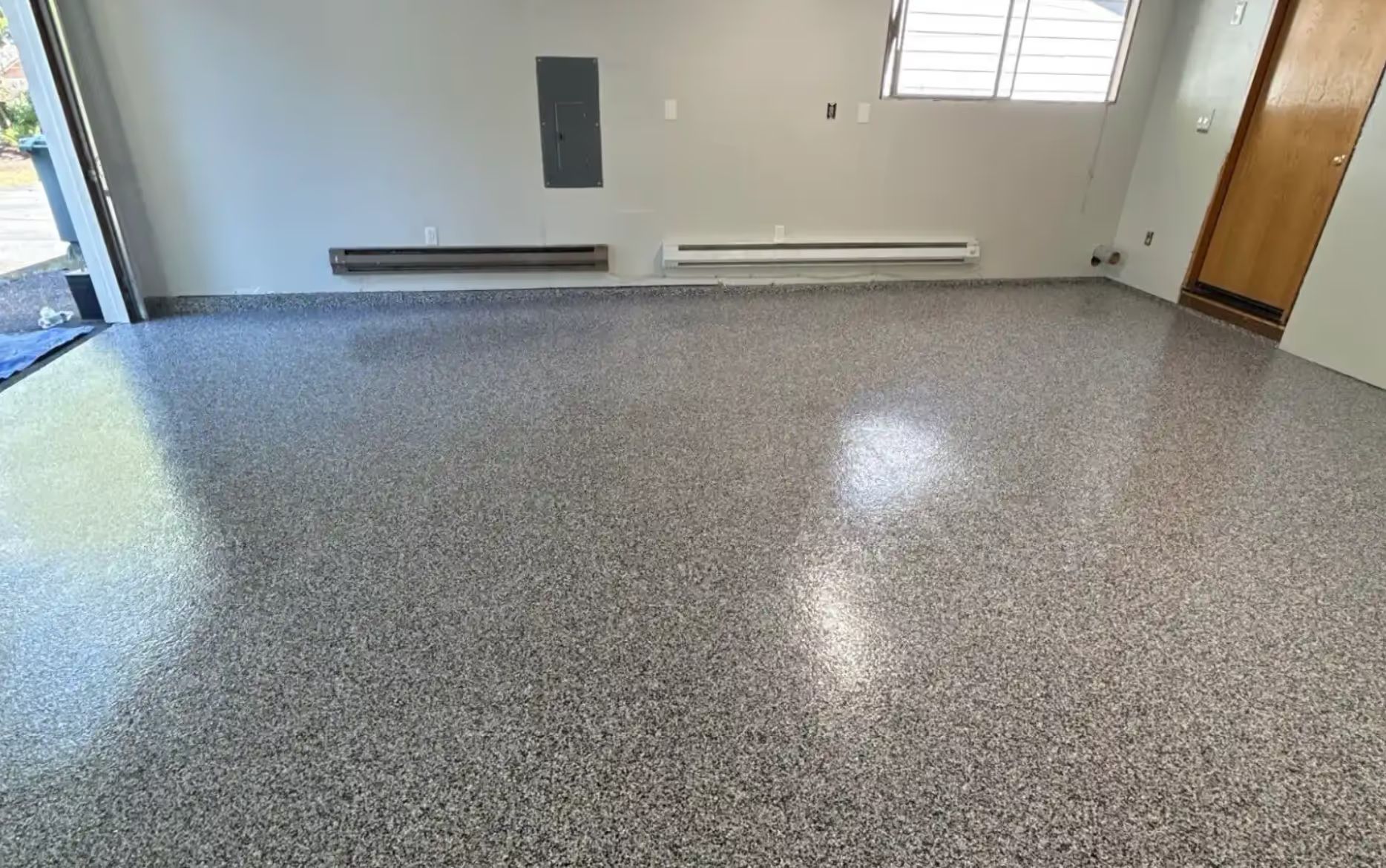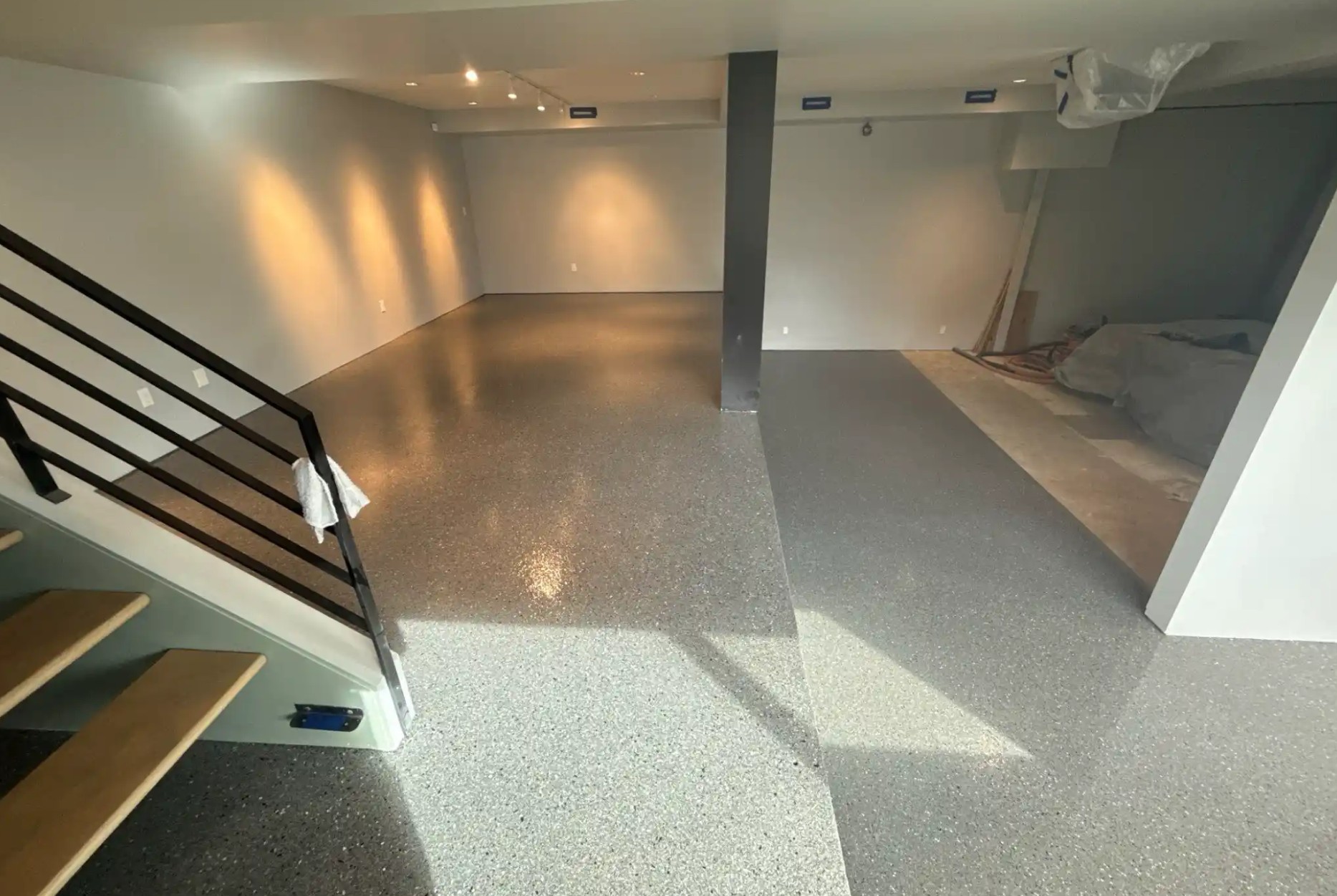
You're standing in your garage, envisioning a beautiful coated floor that transforms your space from dull and drab to stunning and functional. But as you look closer, reality sets in: your concrete isn't perfectly level. There are noticeable dips near the corners, subtle slopes toward the drain, maybe even some raised sections where the slab has settled unevenly over the years.
Now you're wondering: Is coating even possible? Will an uneven surface ruin the final appearance? Should you just abandon the idea altogether?
Here's the straightforward answer: Yes, uneven concrete can absolutely be coated—but the quality of the outcome depends entirely on the expertise of your installer and the preparation methods they use. The difference between a professional coating job and a disappointing failure often comes down to how thoroughly substrate issues are addressed before the first drop of coating touches your floor.
Understanding what's possible, what's required, and what to expect can save you thousands of dollars and years of frustration.
Before diving into solutions, it's helpful to understand why garage floors rarely stay perfectly level over time. This knowledge helps set realistic expectations and reveals why professional assessment is so critical.
Common Causes of Uneven Concrete:
Settling and Ground Movement: Your concrete slab rests on compacted soil that shifts over time due to moisture changes, freeze-thaw cycles, and natural ground settling. Different areas of your garage may settle at different rates, creating uneven surfaces.
Intentional Slopes: Many garage floors are deliberately sloped toward drains or door openings for water management. This isn't a defect—it's by design. However, these slopes need to be accounted for during coating application.
Construction Variables: Not all concrete is created equal. Regional variations in concrete mixtures, different building codes across decades, and varying land conditions mean your garage floor has unique characteristics. Some slabs were poured with more attention to leveling than others.
Spalling and Deterioration: Over time, concrete surfaces can break down through a process called spalling—where the top layer flakes, chips, or crumbles away. This creates uneven texture and depth variations that must be addressed before coating.
Control Joint Variations: The cuts made in concrete to control cracking (control joints) can create slight elevation differences as the slab moves over time.
The key insight? Every garage floor has some degree of unevenness. The question isn't whether your floor is perfectly level—it's whether the variations are within acceptable tolerances for coating, and whether your installer knows how to handle them properly.
Not all uneven floors present the same challenges. Understanding the different categories helps you evaluate your situation realistically.
Characteristics: Slight texture variations, small divots, minor grinding marks from previous work, shallow spalling (less than 1/8 inch deep)
Coating Viability: Highly suitable for coating with proper preparation
Required Approach: Standard professional grinding and surface profiling will level these variations. The coating thickness (typically applied at 20-40 mils) can bridge minor imperfections while creating a smooth, uniform surface.
These types of irregularities are extremely common and present no significant barrier to achieving a beautiful finished floor.
Characteristics: Intentional drainage slopes (typically 1/8 to 1/4 inch per foot), gradual settling creating gentle elevation changes
Coating Viability: Excellent candidates for coating
Required Approach: Professional installers work with these slopes rather than against them. The coating follows the existing pitch, maintaining drainage functionality while creating a smooth, sealed surface. The visual impact is minimal—most people never notice the slope once the floor is beautifully coated.
In fact, maintaining proper drainage pitch is essential for garage floors, and quality coating systems preserve this important feature.
Characteristics: Areas where the concrete has settled substantially (1/2 inch or deeper), bird baths (depressions that hold water), localized sinking
Coating Viability: Can be coated, but requires additional preparation work
Required Approach: These areas need to be filled and leveled before coating application. Professional installers use specialized self-leveling compounds or patching materials designed to bond with concrete and accept coating systems.
The additional preparation increases project cost and timeline, but creates a properly prepared substrate that ensures coating longevity.
Characteristics: Major heaving (significant upward displacement), severe cracking with vertical displacement, widespread deterioration, structural failure
Coating Viability: May not be suitable for coating until underlying structural issues are resolved
Required Approach: These situations require assessment by a structural engineer or concrete specialist. Coating severe structural problems is like painting a house with a failing foundation—it might look better temporarily, but the underlying issues will cause coating failure and continued deterioration.
Reputable coating contractors will be honest about when concrete needs structural repair before coating should be attempted.
If you're considering a DIY coating approach for your uneven floor, understanding the challenges can save you from expensive failures.
Equipment Limitations:
Most homeowners lack the professional grinding equipment needed to properly address uneven concrete. Professional floor grinders weigh over 600 pounds and use high-quality diamond tooling under extreme pressure to profile concrete surfaces. These machines can remove high spots, smooth rough areas, and create the proper surface profile for coating adhesion.
Rental equipment and consumer-grade tools simply cannot achieve the same results. The consequence? Coatings applied over improperly prepared uneven surfaces fail quickly through delamination, bubbling, and peeling.
Skill and Experience Gaps:
Knowing which areas need leveling, how much material to remove, where to apply patching compounds, and how to blend transitions requires years of hands-on experience. DIY installers often:
The time, frustration, and material costs of DIY failures typically exceed the investment in professional installation.
Product Quality Issues:
Over-the-counter coating products from big-box stores aren't engineered for challenging substrates. They lack the flexibility, adhesion strength, and self-leveling properties that professional-grade systems provide. When applied over uneven surfaces, these limitations become magnified, resulting in thin spots, thick spots, and premature failure.
Professional concrete coating installers approach uneven floors with systematic processes designed to create optimal surfaces for long-lasting coatings.
Before any work begins, experienced installers conduct thorough evaluations:
This assessment creates a detailed preparation plan tailored to your specific floor conditions.
Professional substrate preparation transforms uneven concrete into a surface ready for premium coating systems:
Precision Grinding: Using commercial-grade equipment, technicians systematically profile the entire surface. High spots are ground down, surface contamination is removed, and the concrete is opened at the microscopic level to accept coating bonding.
The grinding process removes approximately 1/16 to 1/8 inch of surface concrete, eliminating minor irregularities while creating the proper texture for coating adhesion.
Selective Leveling: Areas with significant low spots receive specialized treatment with patching compounds engineered to:
Edge and Detail Work: Corners, perimeters, and transition areas receive meticulous attention. These areas often have the most pronounced unevenness and require careful preparation to ensure coating integrity.
Uneven floors often have associated cracks where differential settling has occurred. Every crack and imperfection must be properly addressed:
Using rapid-cure polyurea repair systems like Penntek Mender HD, professional installers:
Missed or improperly repaired imperfections become failure points where coatings delaminate and water infiltrates.
After grinding, leveling, and repairs, the substrate undergoes final preparation:
This attention to detail separates professional installations from amateur attempts. Shortcuts in preparation guarantee coating failure, regardless of coating quality.
Even after professional preparation, subtle surface variations remain. Quality coating systems are engineered to handle these through several mechanisms:
Build Thickness: Professional coatings are applied at sufficient thickness (typically 20-40 mils) to bridge minor variations while maintaining integrity. Thin coatings cannot span imperfections and fail at stress points.
Flexibility: Penntek's pure polyurea formulation maintains superior flexibility throughout its lifespan. This flexibility allows the coating to move with substrate variations without cracking or delaminating—a critical advantage over brittle epoxy systems.
Chemical Bonding: Where epoxy creates only a mechanical bond (essentially gripping surface texture), Penntek's polyurea forms chemical bonds at the molecular level with concrete. This bond is stronger than the concrete itself, meaning the substrate would fail before the coating would separate.
This chemical bonding is especially important on uneven surfaces where stress concentrations can occur. Mechanical bonds fail under these stresses; chemical bonds hold firm.
Self-Leveling Properties: Quality coating materials have some self-leveling characteristics that help create smooth transitions across subtle elevation changes. This results in a visually smooth surface even over slightly uneven substrate.
Setting proper expectations ensures satisfaction with your coated floor:
What Professional Coating Can Achieve:
What Coating Cannot Do:
The goal isn't to create a perfectly level surface—it's to create a beautifully coated floor that performs well and looks great despite minor imperfections in the underlying concrete.
Not all coating contractors approach uneven floors with appropriate rigor. Warning signs include:
No Assessment or Discussion: If they quote your job without examining the surface closely or discussing unevenness, they're guessing—and you'll pay the price when the coating fails.
"We'll Just Coat Over It": Any contractor who suggests applying coating directly over significantly uneven concrete without preparation is guaranteeing failure.
Unrealistic Promises: Claiming they'll make your floor "perfectly flat" or ignoring obvious preparation needs indicates inexperience or dishonesty.
Rushing the Timeline: Proper preparation of uneven floors takes time. One-day installations are possible for well-maintained, relatively level floors—but challenging substrates require additional preparation time.
Vague Preparation Plans: Professional installers explain exactly what preparation work your floor needs and why. Vague answers suggest they don't actually know how to handle your situation properly.
Rock-Bottom Pricing: If the quote seems too good to be true, it probably is. Proper substrate preparation requires time, equipment, materials, and expertise—all of which cost money.
When evaluating quotes for coating uneven floors, consider the complete cost picture:
Upfront Investment in Proper Preparation:
Total additional cost for challenging substrate: $600-1,400
Cost of Coating Failure from Inadequate Preparation:
Total cost of cutting corners: $4,500-11,500+
The math is simple: investing in proper preparation delivers the lowest lifetime cost and the best outcome.
When discussing your uneven floor with coating contractors, these questions reveal their competence:
Professional contractors welcome these questions and provide detailed, confident answers. Evasive or dismissive responses indicate problems.
When dealing with uneven floors, the coating system you choose matters as much as the preparation quality. Penntek's pure polyurea technology offers specific advantages for challenging substrates:
Superior Flexibility: Handles substrate movement and variations without cracking or delaminating
Chemical Bonding: Creates permanent bonds that hold even at stress concentration points
Rapid Cure: Mender HD repair systems cure in 30 minutes, allowing efficient project completion
System Integration: Base coat, decorative chips, and topcoat are engineered to work together as a complete system
Certified Installation: Penntek dealers undergo rigorous training specifically including challenging substrate preparation techniques
Lifetime Warranty: Manufacturer-backed warranty protection covers properly prepared uneven floors
This comprehensive approach—quality materials plus expert installation—delivers decades of performance where inferior systems fail in years.
If you've been hesitating to coat your garage floor because of unevenness, now you understand that substrate variations aren't disqualifying—they simply require professional expertise.
Your Next Steps:
Your uneven garage floor isn't a barrier to transformation—it's an opportunity to work with installers who demonstrate true expertise through how they handle preparation challenges.
Key Takeaways:
Ready to transform your uneven concrete into a beautiful, durable floor? Explore coating options designed to handle real-world substrate challenges, or schedule your free assessment to discover exactly what's possible for your specific situation.
Don't let uneven concrete hold you back from the garage you deserve. With the right expertise and coating system, even challenging floors can become showcases.





